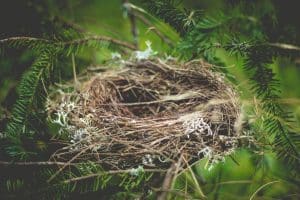by Jayme Brooks, B.Sc., R.PBio.
Intermediate Biologist
As spring approaches, so do sensitive timing periods for a variety of wildlife. Recently, spring bird nesting has become the focus for many local municipalities during the permitting process for development projects. This means restrictions to when and where vegetation clearing may be permitted. In British Columbia, birds and their nests are protected under the provincial Wildlife Act and the Migratory Birds Convention Act (MBCA). These provide protection to the majority of native bird species, including their nests, eggs, and young, from harm, disturbance, or destruction.
When should vegetation clearing occur?
The nesting season, or window, will vary depending on your location. Some municipalities have adopted their own window, which is typically between March 1 and August 31. In the absence of municipal requirements or guidelines, Environment and Climate Change Canada published detailed technical information on the general nesting periods of migratory birds in Canada factoring in differences between regions and habitat types. This information can be used as a guide to determine the high-risk periods when vegetation clearing should be avoided. For project planning in the Lower Mainland and Fraser Valley (part of Zone A1 in the figure below), the nesting window would be March 12 to August 17 across all habitat types, with peak nesting (dates shown in dark red) occurring between May 1 and July 22.
As the season progresses, plans for vegetation clearing will come with an increased risk of contravention with the legislation. Although not a legislated requirement, bird nest surveys can be an effective tool to reduce this risk if vegetation clearing is required during the bird nesting window.
Clearing in the nesting window and bird nest surveys
Bird nest surveys, conducted by a qualified environmental professional, can help identify active nests before vegetation is cleared. Keystone Environmental conducts surveys within four hours of sunrise to capture peak activity periods and decrease the risk of incidental take (i.e., harm or harassment of birds or their nests). The surveys include a combination of passive listening and low-intensity sweeps of the area. This technique allows the surveyor to observe key nesting behaviour and identify potential nests with a lower risk of incidental take during surveys. If a nest is found, a setback is determined based on the species of bird and where it is located. Setbacks are typically a minimum of 10 meters from the nest. This area is then protected until the nest is determined to be inactive.
Keystone Environmental recommends that a qualified environmental professional be consulted before vegetation clearing is planned. In certain habitat types, there is also an increased risk for the occurrence of nests protected year-round under the BC Wildlife Act (i.e., heron, eagle, peregrine falcon, osprey, gyrfalcon, and burrowing owl).
For further clarification regarding regulations protecting birds in BC or for more information on how Keystone Environmental can guide you through this process, please contact Jamie Slogan at ac.la1713552226tnemn1713552226orivn1713552226eenot1713552226syek@1713552226nagol1713552226sj1713552226 or call 604-430-0671.

